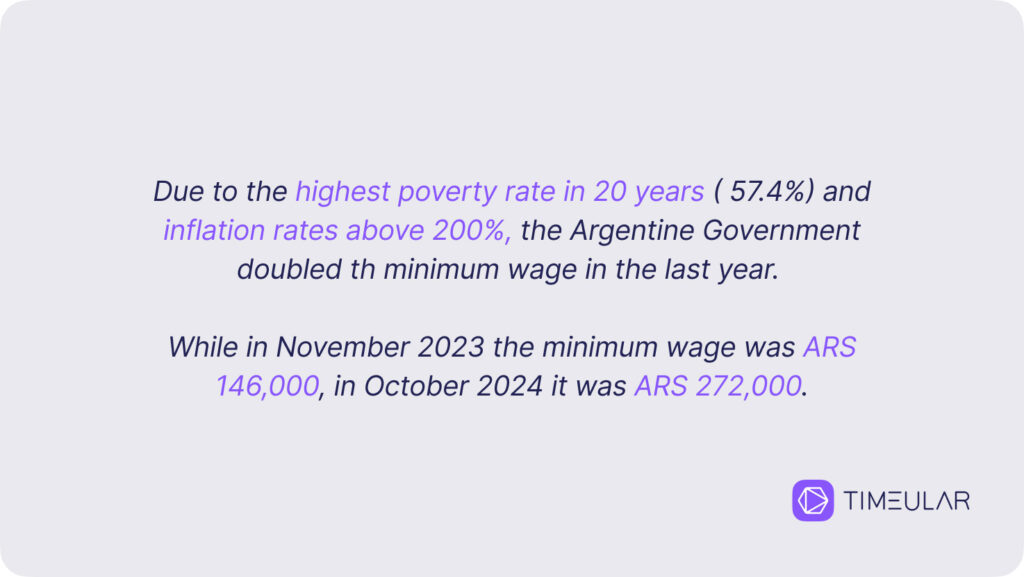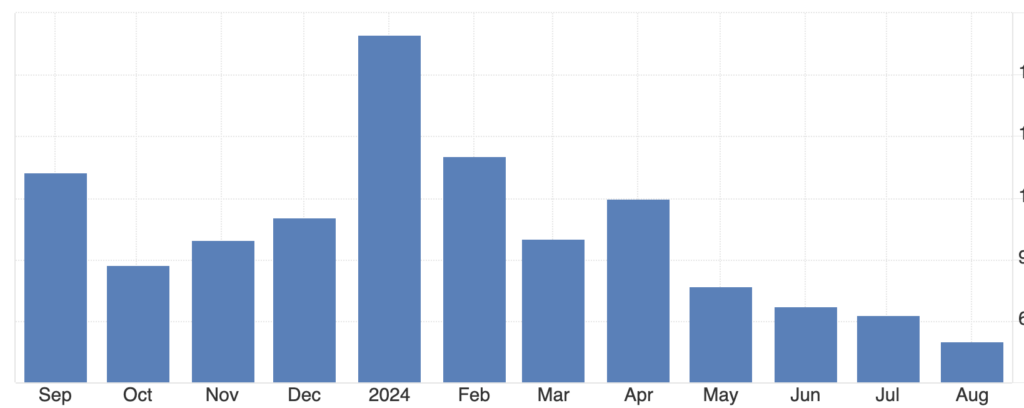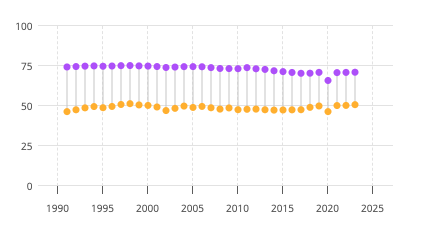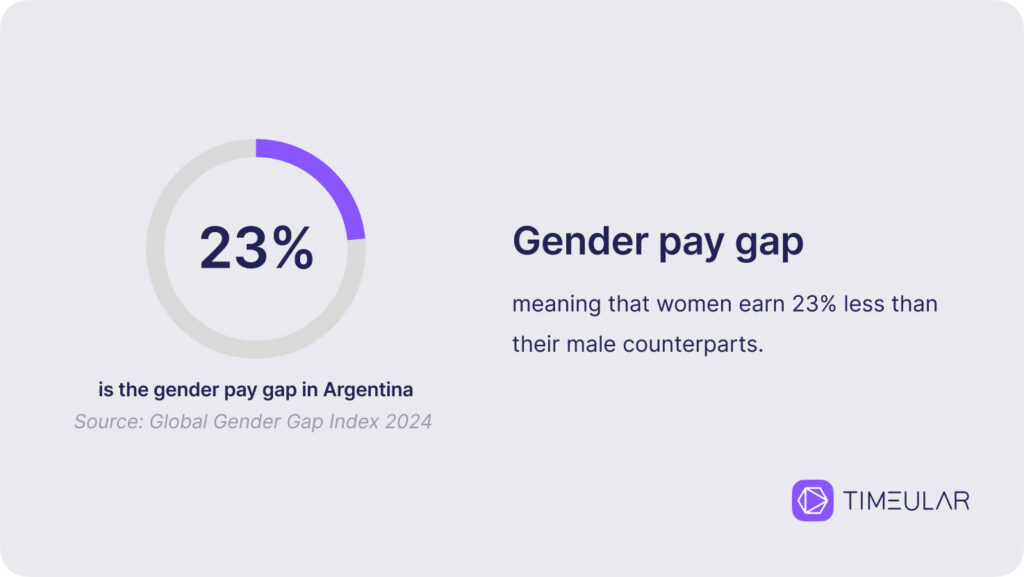Average Salary in Argentina
Latin America’s third economy, Argentina, has an average annual salary of ARS 5,687,088 (USD 5,696.93), according to INDEC. The average monthly salary is ARS 473,924, the equivalent of USD 474.76.
However, the average salary in Argentina fluctuates based on different factors, such as geographical location, someone’s profession, education, or industry. In this article, we will dive into all these factors.
Vær oppmerksom på dette:
- All data in this article are based on official statistics and reports, such as those from The Instituto Nacional de Estadística y Censos (INDEC) and the OECD. Data is linked at the end of the article.
- The official currency of Argentina is the Argentine Peso (ARS).
- One ARS equals 0.0010 USD when writing this article. Please double-check the exchange rate at the time of reading.
Nøkkelstatistikk og makroer:
- Average annual salary: ARS 5,687,088 (USD 5,696.93). Source: INDEC
- Average monthly salary: ARS 473,924 (USD 474.76). Source: INDEC
- Median salary: ARS 370,000 (USD 370.49). Source: INDEC
- Minimum wage: ARS 272,000 (USD 272.36). Source: Trading Economics
- Gender pay gap: 23%Source: World Economic Forum
- High inflation rates: Argentina has experienced consistently high inflation, one of the highest globally, over 200% annually in recent periods.
- 57.4% of the Argentine population lived in poverty in January 2024, according to Reuters.
- Argentina’s minimum wage doubled last year to counterbalance the growing inflation and increase purchasing power.
Average salary in Argentina
The average salary in Argentina in Q2 2024 was ARS 473,924 (USD 474.76) for the employed population every month, according to INDEC. The yearly equivalent is an average wage of ARS 5,687,088 (USD 5,696.93) per year. The typical monthly salary of a formal employee with pension deductions is ARS 638,811 (USD 639.92) per month.
According to INDEC, the Wage Index increased by 4.7% monthly and 181.9% year over year in September 2024. This monthly growth is due to increases in average salaries. More specifically, 3.8% are in the private sector, 3.9% in the public sector, and 10.4% in the unregistered private sector.
Medianlønn
The same report from INDEC on the evolution of income distribution in 2024 surfaces a salary range ARS 370,000 (USD 370.49) per month.
This median represents the dividing line of the average earnings in Argentina, providing a more realistic picture of average wages. The median salary also reflects that 50% of Argentinian employees earn less than the median salary, while the other half earn more than the median salary.
In other words, 50% of the Argentinian workers have higher average salaries than ARS 370,000, while 50% falls below this figure, with lower average salaries.
Minstelønn
With the highest poverty rate in 20 years, namely 57.4%, and high inflation rates, the Argentine government had to continuously increase the minimum wages across the last months.
Therefore, the minimum wage in October 2024, according to Trading Economics, reached ARS 272,000 (USD 272.36) monthly, while in the same month last year, the minimum wage was ARS 146,000 (USD 146.19). The minimum wage growth was considerable month after month in the last year, with approximately 15% monthly increases.

Argentina closed in 2023 with huge economic fluctuations and inflation roughly equivalent to 211.4%, with a 20% increase in January 2024. The Government is trying to offer more competitive salaries and better life conditions for Argentinian employees to counterbalance the economic challenges.
Gjennomsnittslønn per region
When it comes to regional disparities, Argentina still faces structural economic inequalities that have persisted despite national economic development efforts in the last years.
Average salaries vary significantly depending on whether employees are based in the Patagonian provinces (south) and the capital city, Buenos Aires, and its metro area. These regions have higher average salaries and lead by a salary range of ARS 400,000-533,000, driven by oil/gas and services.
On the other side of the spectrum are the northern provinces, which lag significantly at ARS 180,000-270,000, creating a nearly 3:1 income gap between the richest and poorest regions.
Here’s a ranked table of monthly household incomes by geographical location in Q3 2023, according to the INDEC report on “Condiciones de vida.”
| Province | Average Monthly Household Income (ARS) |
| Tierra del Fuego | 533,077 |
| CABA | 513,057 |
| Neuquén | 440,277 |
| Santa Cruz | 433,199 |
| Chubut | 402,422 |
| La Pampa | 384,96 |
| Buenos Aires | 356,222 |
| Santa Fe | 330,119 |
| San Juan | 329,013 |
| Córdoba | 323,394 |
| Corrientes | 319,586 |
| Salta | 305,356 |
| Tucumán | 296,844 |
| San Luis | 294,063 |
| Entre Ríos | 293,634 |
| Catamarca | 293,496 |
| Mendoza | 292,952 |
| Jujuy | 292,798 |
| Río Negro | 290,626 |
| Misiones | 269,003 |
| Santiago del Estero | 254,773 |
| Formosa | 246,539 |
| La Rioja | 219,945 |
| Chaco | 183,401 |
Average salary by industry and occupation
The average salary in Argentina varies widely based on various industries and professions due to factors such as the level of specialized skills and labor costs involved.
Average salaries for healthcare professionals like dieticians or software developers from the technology sector or managerial positions in Finance, Engineering are the highest salaries (ARS 42,000-94,200). In contrast, entry-level administrative and social services roles remain at the lower end (23,000-28,000 ARS).
The progression from junior to senior roles shows a consistent 2-3x salary increase across most sectors, with Financial Manager positions showing the highest multiplier at nearly 4x the entry-level salary.
For job seekers looking for positions in high demand or higher salaries, here is a comprehensive list with salary levels in key sectors:
| Kategori | Stilling | Average Salary (ARS) |
| Regnskap og finans | Accounting Assistant | 26,200 |
| Regnskapsfører | 33,200 | |
| Økonomisjef | 94,200 | |
| Administrasjon | Resepsjonist | 23,300 |
| Administrativ assistent | 24,000 | |
| Office Manager | 41,000 | |
| Reklame | Grafisk designer | 29,100 |
| Art Director | 44,800 | |
| Kreativ direktør | 48,000 | |
| Ingeniørarbeid | Engineer | 42,000 |
| Elektroingeniør | 47,300 | |
| Sivilingeniør | 44,300 | |
| Human Resources | HR Officer | 28,000 |
| HR Manager | 67,200 | |
| HR Director | 89,200 | |
| Informasjonsteknologi | Computer Technician | 37,000 |
| Developer/Programmer | 44,600 | |
| IT Manager | 79,300 | |
| Helsetjenester | Dietitian | 93,700 |
| Sykepleier | 36,400 |
Gjennomsnittslønn etter utdanning
Data from INDEC shows that there is a clear link between someone’s education level and their employment status, as employees with education are in higher demand. Hence, in Q2 2024, follow these trends:
- Workers with university degrees:
- Have a higher employment rate (25.2% of the employed population)
- Have a lower unemployment rate
- Are more likely to be in professional/technical positions
- People with incomplete secondary education:
- Represent 16.6% of the employed population
- Have a higher unemployment rate (23.7% of unemployed)
- Are more likely to be in operational positions
- People with secondary education complete:
- Represent 29.5% of the employed population
- Represent 35.5% of the unemployed population
- Have a mix of operational and technical positions
Wage growth trends in Argentina
In September 2024, an INDEC report showed that the average salary in Argentina has increased by 181.9%.
The average wage growth in Argentina has been extremely volatile. It is marked by high growth but severe real losses due to hyperinflation. In January 2024, wage growth was 19.99%, contrasting with the significant real wage deterioration and the purchasing power.
In December 2023, there was a currency devaluation of 118.3%, which triggered a dramatic 15% real wage decline in six months. The wage gap is widening, and the purchasing power keeps on decreasing in Argentina. This reflects both the country’s economic instability and growing income inequality, particularly impacting lower-income workers who face disproportionate purchasing power erosion from food price inflation (+65% in Dec 2023-Feb 2024).
The illustration below reflects growth trends in wages in Argentina in 2024:

Source: TradingEconomics
Lønnsforskjeller mellom kvinner og menn
According to the World Bank, in 2023, the labor force participation rate among females was 50.8%, while among males, it was 71.1%. However, labor force participation has increased among women since 1990.

Source: World Bank
At the same time, data from the Global Gender Gap Index by the World Economic Forum proves that Argentine women earned only 77% of what their male counterparts earned for similar jobs in 2024.

Interesting labor market facts about Argentina
Dynamikk i arbeidsmarkedet:
- Employment and unemployment rates: In the second quarter of 2024, Argentina’s employment rate was 44.8% in urban areas, according to INDEC. During this period, the unemployment rate reached 7.6%, reflecting the job scarcity and economic challenges in Argentina. Moreover, underemployment, meaning workers searching for more hours or better positions, was recorded at 11.8%. This clearly highlights a persistent labor underutilization.
- Informal employment: A considerable part of Argentina’s workforce works in informal setups without being protected by social protections and other benefits. This labor market segment is highly vulnerable to economic downturns.
- Strong labor unions: Argentina’s labor unions, led by the CGT, have significant control over wage negotiations. These unions frequently influence national policy with their ability to organize large strikes and manage employee healthcare systems.
- Frequent minimum wage changes: In Argentina’s high inflation environment, with over 200% inflation, adjusting the minimum wage has become an almost constant practice. This helps catch up with rising prices and increases purchasing power. In the last year, since November 2023, the minimum wage has doubled.
- Expanded service sector: The service sector accounts for about 60% of total employment in Argentina. The Argentine economy’s service-dominated market, with activities ranging from retail and public administration to tourism and financial services, employs most workers, particularly in urban centers like Buenos Aires.
Økonomiske indikatorer og trender:
- High inflation rates: Argentina has consistently experienced high inflation, one of the highest globally, over 200% annually in the last years. This led to a high decrease in purchasing power.
- Economic informality and SMEs: Small and medium-sized enterprises (SMEs) are pivotal to Argentina’s economy but often operate informally due to tax pressures. These businesses are key drivers of employment, though their growth is stifled by limited access to credit and economic instability.
- Currency volatility: The Argentine Peso has been extremely devaluated in recent years, creating pressure on both wages and savings. That’s why currency instability led to dollarization trends, as many Argentines held foreign currency to preserve value during Peso depreciation.
- External debt: Argentina has a large external debt, which impacts its ability to allocate resources toward domestic investment. Debts have influenced government policy decisions and often resulted in austerity measures that affect public sector employment and social spending.
VANLIGE SPØRSMÅL
What is the average income in Argentina?
The average income in Argentina is around ARS 473,924 (USD 474.76) per month and ARS 5,687,088 (USD 5,696.93) per year.
What is a middle-class salary in Argentina?
The middle-class salary range in Argentina is situated around the median figure of ARS 370,000 (USD 370.49) per month, which is ARS 4,440,000 (USD 4,445.58) per year.
What is the basic wage in Argentina?
The basic wage in Argentina is ARS 272,000 (USD 272.36) monthly, which was applied in October 2024.
Les mer om dette:
- Gjennomsnittslønn i Nigeria
- Gjennomsnittslønn i Costa Rica
- Gjennomsnittslønn i Australia
- Gjennomsnittslønn i India
- Gjennomsnittslønn i Colombia
- Gjennomsnittslønn i Sør-Korea
- Gjennomsnittslønn i Thailand
- Gjennomsnittslønn i Kina
- Gjennomsnittslønn i Canada
- Gjennomsnittslønn i USA
- Gjennomsnittslønn i Sveits
- Gjennomsnittslønn i Spania
- Gjennomsnittslønn i Italia
- Gjennomsnittslønn i Tyskland
- Gjennomsnittslønn i Mexico
- Gjennomsnittslønn i Pakistan
- Gjennomsnittslønn i Polen
- Gjennomsnittslønn i Romania
- Gjennomsnittslønn i Frankrike
- Gjennomsnittslønn i Filippinene
- Gjennomsnittslønn i Vietnam
- Gjennomsnittslønn i Japan
- Gjennomsnittslønn i Storbritannia
Kilder:
https://www.indec.gob.ar/uploads/informesdeprensa/ingresos_2trim249B99F4B40F.pdf
https://tradingeconomics.com/argentina/wages
https://genderdata.worldbank.org/en/economies/argentina
https://sdds.indec.gob.ar/nsdp.htm
https://www.indec.gob.ar/uploads/informesdeprensa/eph_pobreza_09_241C2355AD3A.pdf
https://www.indec.gob.ar/uploads/informesdeprensa/eph_total_urbano_ingresos_02_24918E35EE9D.pdf